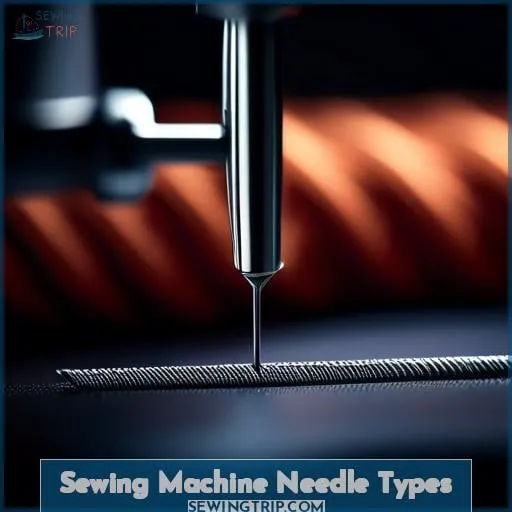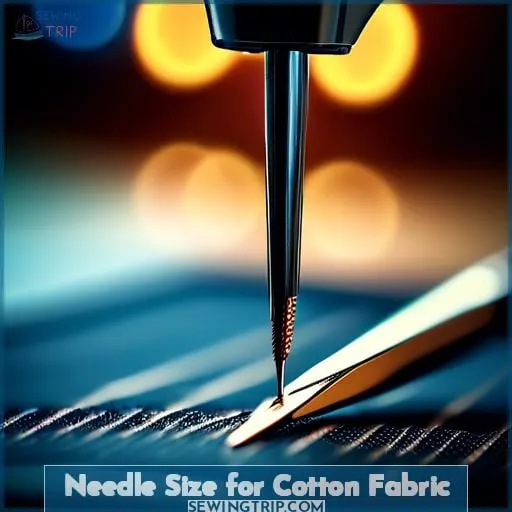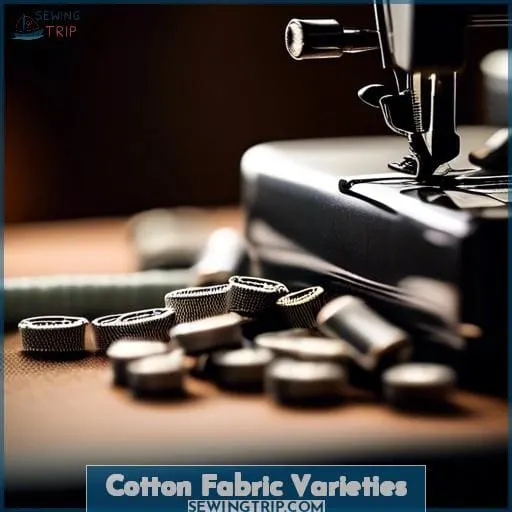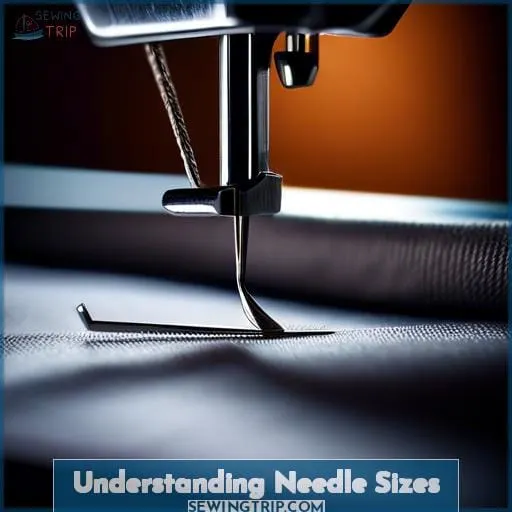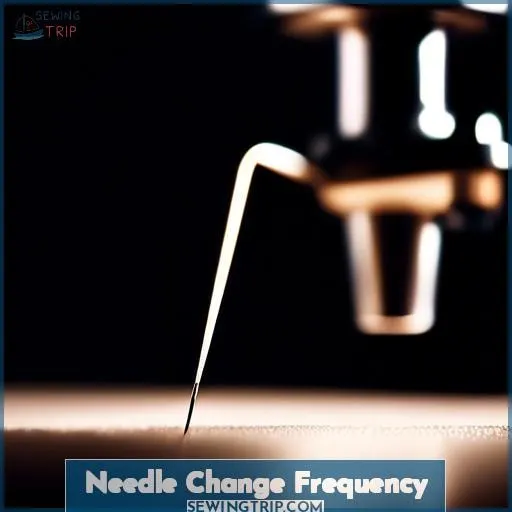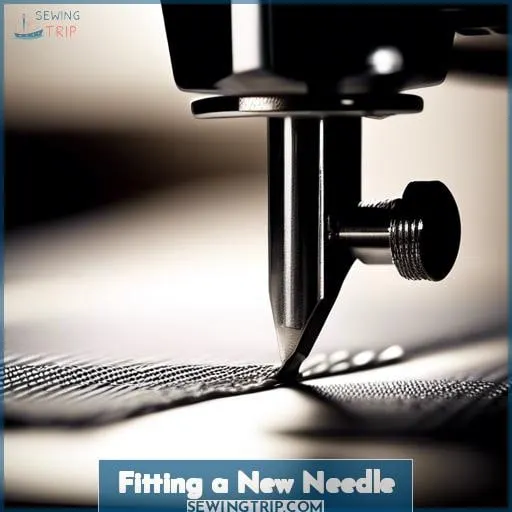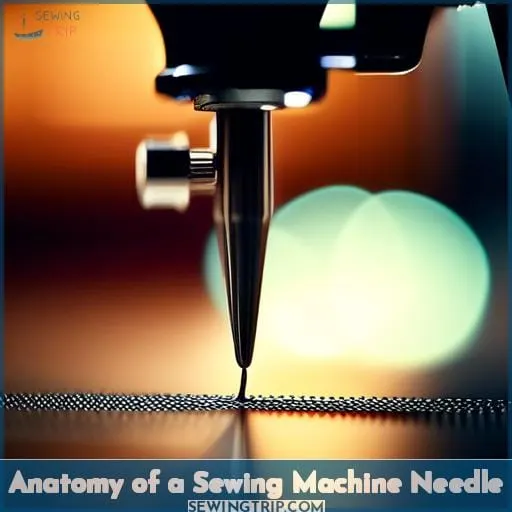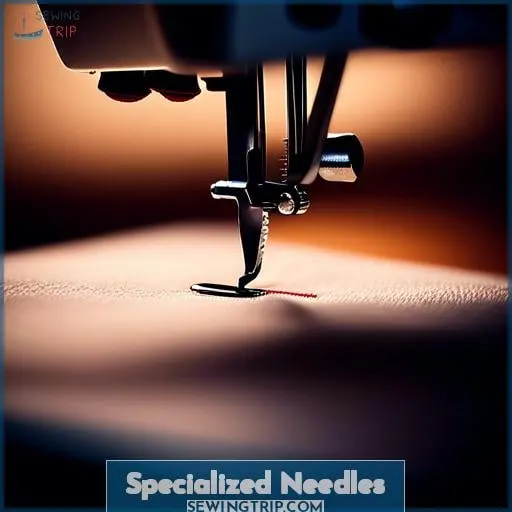This site is supported by our readers. We may earn a commission, at no cost to you, if you purchase through links.
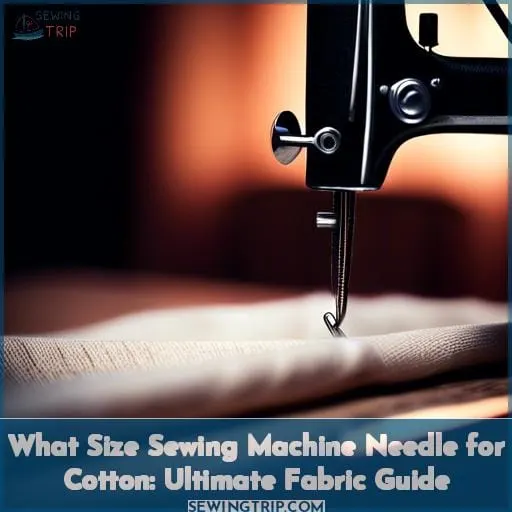 Choosing the right sewing machine needle for cotton can feel like navigating a maze, especially if you’re new to sewing or have faced challenges with fabric damage or poor stitch quality in the past.
Choosing the right sewing machine needle for cotton can feel like navigating a maze, especially if you’re new to sewing or have faced challenges with fabric damage or poor stitch quality in the past.
You might think any needle will do, but the truth is, using the correct size and type of needle can make a significant difference in your sewing projects. Whether you’re working with lightweight, medium weight, or heavy cotton, there’s an ideal needle size to ensure smooth sewing and beautiful results.
This guide will demystify sewing machine needles, helping you select the perfect size for various cotton fabrics, from delicate percale to sturdy corduroy, and everything in between. Let’s dive into the ultimate fabric guide to find out what size sewing machine needle is best for cotton, and elevate your sewing game to new heights.
Yes, for sewing cotton, a 90/14 needle size is recommended as it is great for medium weight fabrics like poplin, broadcloth, and muslin, which includes printed quilting cotton. This size balances the need for strength to penetrate the fabric without damaging it.
Table Of Contents
Key Takeaways
- Needle size selection is crucial for sewing cotton fabrics, with recommendations including 70/10 for lightweight, 80/12 for medium weight, and 90/14 for heavy cotton.
- Universal needles are generally suitable for most cotton fabrics, but specific types like sharp, ballpoint, stretch, and quilting needles are recommended for precise stitching, man-made materials, stretch fabrics, and multiple layers, respectively.
- For cotton fabric varieties, needle sizes vary: 70/10 or 80/12 for percale, 80/12 for poplin, 90/14 for broadcloth, 80/12 or 90/14 for corduroy, and 80/12 for Oxford cloth.
- Regular needle maintenance is advised, including changing the needle every 3-4 projects or when stitch quality declines, to prevent issues like skipped stitches, fabric damage, and thread breakage.
Sewing Machine Needle Types
When selecting the right sewing machine needle for cotton, it’s essential to consider the needle type and size that best matches the fabric’s weight and weave.
For most cotton fabrics, universal needles are a versatile choice, suitable for a wide range of cotton weights from lightweight to medium. Sizes 70/10 to 90/14 are commonly recommended, with the finer 70/10 size being ideal for lightweight cottons like voile, and the slightly thicker 90/14 size better suited for medium weight cottons such as quilting cotton.
Additionally, sharp needles can be used for precise stitching on cotton, especially for detailed work or densely woven cotton fabrics. The key is to match the needle size to the fabric’s weight to ensure smooth sewing and prevent damage to the fabric.
Universal Needles
When it comes to universal needles, they’re the jack-of-all-trades in your sewing kit. Think of them as the Swiss Army knife for your fabric adventures. With their slightly rounded point, they’re ready to tackle both woven and knit fabrics without breaking a sweat.
Whether you’re stitching up a storm on cotton or cozying up to some knits, these needles have got your back.
Now, let’s talk shop about needle size. If you’re working with cotton fabric, you’ll want to pick your needle gauge like you’d pick a good pair of jeans – it’s got to be just right. For lightweight cotton, a size 70/10 will do the trick, gliding through the fabric like a hot knife through butter.
Medium weight cotton calls for an 80/12, a trusty sidekick for fabrics that aren’t too finicky. And when the going gets tough with heavy cotton, a 90/14 needle steps up to the plate, ready to hit a home run.
So, keep your fabric weight in mind, and choose your universal needles wisely. They’re the unsung heroes of the sewing world, ready to weave some magic on your cotton fabric without a hitch.
Ball Point Needles
When you’re stitching up a storm on man-made materials like polyester or interlock fabric, you’ll want to reach for ballpoint needles. These sewing machine needle types are the unsung heroes for your knit fabric projects.
With a needle point that’s more of a gentle nudge than a sharp poke, they glide between fibers rather than piercing through, preventing those pesky snags and runs. Think of them as the fabric whisperers, coaxing the threads aside with the finesse of a diplomat.
Stretch Needles
When sewing with stretch fabrics, you’ll want to use stretch needles to avoid the dreaded skipped stitches and puckering. These needles are specifically designed to work with elastic materials like spandex and Lycra, which are common in activewear and swimwear.
- Stretch needles have a medium ball point to prevent damage to the fabric.
- Twin needles can be used for parallel rows of stitching, adding a professional touch.
- Overlock stitches and serger machines are perfect for stretch fabrics, creating durable seams.
- Elastic materials require needles that can glide through without breaking the fibers.
- Regular maintenance, like changing your sewing machine needle frequently, ensures the best results.
Sharps Needles
When it comes to sewing cotton, you can’t go wrong with sharps needles. These trusty tools are like the Swiss Army knives of the sewing world—versatile and reliable for a range of cotton fabrics.
Whether you’re stitching up a storm on a percale or poplin, a size 70/10 or 80/12 needle will glide through like a hot knife through butter. But if you’re tackling something heftier like broadcloth, you might want to beef it up to a size 90/14 to avoid any sewing snafus.
Quilting Needles
When it comes to quilting, you’ll want to reach for quilting needles that can handle the multiple layers and seams you’ll be stitching through. These needles are designed with a sharp, tapered point, perfect for piecing quilts and machine quilting the layers together.
For most cotton quilting projects, a size 70/10 or 80/12 needle will do the trick, ensuring your stitches are even and your quilt durability is top-notch. Remember, the right needle size not only contributes to the quality of your stitch but also to the ease of your sewing experience.
If you’re working with a particularly thick quilt or a heavy cotton, you might consider a 90/14 needle to ensure it can handle the fabric thickness without breaking a sweat—or a needle! Keep an eye on your stitch quality and tension adjustment; if you notice any hiccups, it might be time to switch up your needle size.
And don’t forget, a dull needle can be the culprit of many sewing woes, so change them out regularly to keep your sewing machine humming happily.
Needle Size for Cotton Fabric
When selecting the appropriate sewing machine needle for cotton fabric, it’s essential to consider the weight of the material.
For lightweight cotton, such as cotton lawn, a size 70/10 needle is recommended, ensuring delicate fabric is sewn without damage.
Medium weight cottons are best served with a size 80/12 needle, which is versatile and commonly used for a wide range of cotton fabrics.
If you’re working with heavy cotton, a size 90/14 needle will provide the strength needed to handle the fabric’s thickness without breaking.
Size 70/10 for Lightweight Cotton
For sewing lightweight cotton fabrics, you’ll want to reach for a size 70/10 needle.
- Needle Sharpness: The 70/10 needles have a slightly rounded point, making them versatile for both knits and wovens.
- Cotton Fabric Care: Use warm or cool water to prevent shrinking and maintain the integrity of your cotton.
- Sewing Machine Tension: Aim for a standard tension setting around 4 for a balanced stitch on cotton.
- Cotton Thread Selection: Pair your needle with a quality cotton or polyester-cotton thread for the best results.
Size 80/12 for Medium Weight Cotton
For sewing medium weight cotton fabrics, you’ll want to use a size 80/12 sewing machine needle. This size is the sweet spot for fabrics that aren’t too delicate or too heavy, like your trusty cotton poplin or broadcloth.
The 80/12 needle has a diameter that’s just right for handling the fabric weight and thread thickness typically used with medium weight cotton, ensuring your stitches are even and your fabric isn’t damaged.
Size 90/14 for Heavy Cotton
When tackling heavy cotton projects, you’re stepping into a realm where precision meets durability.
- Needle Size: Opt for a 90/14 needle. This size is your knight in shining armor, ready to pierce through the robustness of heavy cotton without breaking a sweat.
- Thread Size: Match your needle with the right thread size. A thicker thread complements the needle, ensuring your stitches are as strong as they’re beautiful.
- Stitch Quality: Expect nothing less than perfection. The right needle and thread combo means your stitches will be uniform, holding your creation together with grace.
- Needle Maintenance: Don’t forget, even the mightiest warriors need rest. Change your needle after 6-8 hours of sewing to maintain peak performance.
Cotton Fabric Varieties
When selecting the right sewing machine needle for cotton fabrics, it’s important to consider the specific variety of cotton you’re working with.
For instance, percale fabric, known for its tight weave and crisp feel, may require a different needle size compared to poplin fabric, which is also tightly woven but has a smoother finish.
Broadcloth, with its dense texture, might need a needle that can handle its weight, while corduroy, with its raised ‘cords’ or ribs, could necessitate a needle that can navigate the fabric’s texture without damaging it.
Lastly, oxford cloth, typically used for shirts, has a basketweave structure that might also influence the choice of needle size.
Generally, a size 70/10 to 80/12 needle would be suitable for these types of cotton fabrics, as they’re medium-weight.
Percale Fabric
Moving from the general needle sizes for cotton fabrics, let’s talk about percale cotton. This tightly woven fabric, often celebrated for its durability and breathability, is a dream for those warm summer nights.
You’ll want to use a needle that complements percale’s fine qualities—think a size 70/10 or 80/12 needle to handle its lightweight nature without a hitch. Just like finding the perfect pair of jeans that fit just right, choosing the correct needle for percale is about marrying the fabric’s thread count and weave pattern with the needle’s capabilities.
So, while you wouldn’t use jeans needles or leather needles here, a sharp, top stitch needle could be your best buddy for a crisp, clean finish. And remember, just like a twin needle can create two perfect parallel lines, the right needle for percale will ensure your seams are nothing short of impeccable.
Poplin Fabric
Poplin fabric, with its crisp feel and smooth surface, is a dream to work with, especially when you’re aiming for that sharp, professional look. It’s like the Swiss Army knife of fabrics—versatile enough for anything from a snazzy dress shirt to a breezy summer dress.
But remember, not all heroes wear capes—some just come with the right sewing machine needle.
- For poplin’s medium weight, a Size 80/12 needle is your go-to gadget.
- If you’re dealing with a lighter poplin weave, you might switch to a Size 70/10 for a smoother operation.
- And for those beefier poplin projects, a Size 90/14 needle will punch through without throwing a tantrum.
Just imagine the needle as your fabric’s dance partner—the better the match, the smoother the tango.
Broadcloth Fabric
When you’re cozying up to your sewing machine with a stack of broadcloth, you’re in for a treat. This fabric is the Swiss Army knife of the cotton world—versatile enough for everything from crisp button-downs to those quilts that grandma used to make.
Broadcloth’s tight weave gives it a smooth, lustrous finish that’s a dream to work with. But remember, it’s not a fan of stretching, so keep those triple needles at bay.
Whether you’re crafting a sharp office look or adding a splash of pattern to your home, broadcloth’s got your back.
Corduroy Fabric
Moving from the smooth plains of broadcloth to the textured terrain of corduroy, you’re in for a delightful challenge. Corduroy’s signature ridges, known as wales, add a dash of depth to your projects, but they also call for a needle that can handle the fabric’s valleys and peaks.
You’ll want a needle that’s tough enough to tackle the cotton thickness without turning your seam finish into Swiss cheese.
For mid-weight corduroy, a size 80/12 or 90/14 needle should do the trick, ensuring needle durability and optimal needle performance. If you’re working with a heavier corduroy, consider a size 90/14 to 100/16 to maintain that durability without compromising the fabric’s stretchiness or texture.
Remember, the right needle size not only makes your sewing machine hum a happy tune but also keeps those pesky wales from becoming unintended pin cushions.
Oxford Cloth
When it comes to Oxford cloth, you’re dealing with a classic. This fabric is a real workhorse, perfect for everything from a crisp button-down shirt to cozy bedding and even durable upholstery for your home.
- Needle Size: For Oxford cloth, you’ll want to use a needle that can handle its medium weight. A size 80/12 should do the trick, ensuring your stitches are neat and tidy.
- Needle Type: Stick with a universal needle for this all-rounder fabric. It’s like the Swiss Army knife of sewing machine needles – versatile and reliable.
- Needle Brand: Don’t skimp on quality. A reputable brand like Schmetz will give you the longevity and performance you need for your sewing projects.
Understanding Needle Sizes
When selecting a sewing machine needle for cotton, it’s essential to consider both the size and type of needle for the best results.
Needles are sized using both the metric and imperial systems, with the metric size indicating the diameter in millimeters and the imperial size represented by a size number.
For instance, a 90/14 needle size means the needle’s diameter is 0.9mm, and it corresponds to the imperial size 14.
Generally, a size 80/12 needle is suitable for most cotton fabrics, which is a medium-sized needle that can handle the weight and weave of cotton without causing damage.
Metric Vs. Imperial
Continuing from the various cotton fabric types, it’s essential to understand needle sizes to ensure your sewing project turns out just right. You’ll encounter two main sizing systems for sewing machine needles: metric and imperial.
The metric size indicates the needle diameter in millimeters, while the imperial size is a number that represents the needle size.
| Metric Size (mm) | Imperial Size | Best for Cotton Fabric Type |
|---|---|---|
| 0.7 | 70/10 | Lightweight Cotton (e.g., voile) |
| 0.8 | 80/12 | Medium Weight Cotton (e.g., poplin) |
| 0.9 | 90/14 | Heavy Cotton (e.g., denim) |
| 1.0 | 100/16 | Upholstery Cotton |
| 1.1 | 110/18 | Very Heavy Cotton |
Size Number Meaning
Understanding needle sizes can feel like you’re trying to crack a secret code, but it’s actually pretty straightforward once you get the hang of it. Think of needle sizes like a game of darts: the lower the number, the finer the needle, just as a lower score in darts means a more precise throw.
In the metric system, the needle size represents the diameter of the needle’s shaft in millimeters times 100, so a size 90 needle is actually 0.
On the flip side, the imperial system uses a simple size number, where a size 10 needle corresponds to a 70 in the metric system. When selecting a needle, it’s like picking the right arrow for your bow; you want the perfect match for your fabric’s armor.
A mismatched needle can lead to a fabric battlefield, with snags and puckers as casualties. So, remember to choose wisely and keep your sewing machine’s arsenal well-stocked with the right needle size for your textile adventures.
Needle Change Frequency
When sewing with cotton, it’s crucial to keep your sewing machine needle in top condition to ensure the best results.
You should change your needle every 3-4 projects or whenever you notice a decline in stitch quality or hear unusual sounds from your machine.
This practice helps prevent issues like skipped stitches, fabric damage, and thread breakage, ensuring your sewing remains smooth and your projects look professional.
General Guidelines
When it comes to sewing with cotton, you’re in for a smooth ride if you play your cards right with needle selection. Think of your sewing machine needle as the fairy godmother to your cotton fabric—it can make or break the magic of your creation.
For those lightweight cotton whispers like voile, a Size 70/10 needle will do the trick without a hitch. Medium weight cottons, like your trusty poplin, will cozy up nicely with a Size 80/12 needle. And when you’re dealing with the heavyweights, a Size 90/14 needle will tackle the job without breaking a sweat.
And let’s not forget, needles aren’t immortal. They’ll dull faster than a teenager’s interest in family game night. So, after every few projects or when your stitches start to look like they’ve been on a bender, it’s time to switch out that needle.
It’s a small change that can save you from a world of snagged fabrics and botched seams. Keep a keen eye on your needle’s performance, and you’ll be stitching your way to perfection in no time.
Signs for Replacement
When you’re deep in the rhythm of stitching and suddenly your needle snaps, it’s a telltale sign that it’s time for a change. Needle maintenance isn’t just busywork; it’s the secret sauce to seamless sewing.
If you’re spotting skipped stitches, your fabric snagging, or tension issues that make you want to pull your hair out, it’s your machine’s way of saying, Hey, let’s switch things up! Remember, the right needle size and type are like a good dance partner for your fabric—they’ve got to be in sync for that perfect performance.
And if you’re constantly dealing with a broken needle, it’s a sign that your needle-fabric compatibility might be off. Don’t skimp on needle durability and precision; they’re the unsung heroes of your sewing saga.
Fitting a New Needle
After discussing when to replace your sewing machine needle, let’s dive into the nitty-gritty of needle fitting. It’s a breeze once you get the hang of it, and it can make a world of difference to your sewing experience.
- Raise the Presser Foot: This gives you room to maneuver. Think of it as opening the door to welcome a new guest into your sewing machine’s house.
- Insert the Needle: Hold the needle with the flat side facing the back and slide it up into the clamp. It’s like finding the perfect spot for that guest to sit at the dinner table.
- Secure the Needle: Tighten the clamp’s screw firmly. You wouldn’t want your guest slipping off their chair, right?
Anatomy of a Sewing Machine Needle
Continuing from where we left off on fitting a new needle, let’s dive into the anatomy of a sewing machine needle, which is quite the unsung hero of your sewing escapades. Picture this: the needle is like a tiny knight, armed with various parts, each with its own noble quest to create the perfect stitch.
At the top, you have the butt, which isn’t just a funny word but the part that gets cozy with your machine. Then there’s the shank, the needle’s broad shoulders that ensure it sits just right.
Moving down, we encounter the blade or shaft, the needle’s trusty steed, whose girth determines the needle size. The groove runs along the blade like a secret passage guiding the thread to the eye—the needle’s window to the thread’s soul.
And let’s not forget the scarf, a little nook that’s all about making loop-de-loops with the thread.
Now, the business end: the point and tip. These are the needle’s lance and sword, varying in sharpness and shape to conquer different fabric realms, from the softest cotton to the toughest leather. Choosing the right needle for your cotton project is like picking the right weapon for battle—it can mean the difference between victory and defeat, or in sewing terms, between a smooth seam and needle breakage.
Specialized Needles
When selecting the appropriate sewing machine needle for cotton, it’s essential to consider the weight of the fabric.
For most cotton fabrics, a 90/14 needle is a versatile choice, especially when working with medium weight cotton like poplin, broadcloth, or muslin.
If you’re using a finer cotton, such as cotton lawn, an 80/11 needle may be more suitable to prevent damage to the delicate fabric.
Always ensure you’re using the right needle size to enhance your sewing experience and achieve the best results.
90/14 Needle Usage
Continuing from the anatomy of a sewing machine needle, let’s dive into the specifics of the 90/14 needle usage. This needle size is your go-to when you’re dealing with medium weight cotton fabrics. It’s like finding the perfect dance partner for poplin, broadcloth, and muslin—just the right balance of sharpness and strength to glide through the fabric without causing a scene.
- Needle Sharpness: The 90/14 needle has the precision to handle cotton’s weave without snagging.
- Fabric Weight: Ideal for medium weights, it ensures your sewing machine doesn’t skip a beat.
- Thread Tension: It plays nice with your thread, keeping tension woes at bay, so you can sew without a hitch.
80/11 Needle Usage
When you’re working with lightweight cottons, an 80/11 needle is your secret weapon for a crisp seam finish. It’s like having a trusty sidekick in your sewing arsenal, ensuring every stitch is on point.
This needle’s sharpness and durability are perfect for tackling those delicate fabrics without breaking a sweat. It’s versatile enough to handle varying fabric densities and thread thicknesses, making it a go-to for sewists aiming for needle accuracy.
Here’s a quick table to help you remember why an 80/11 needle is a great choice:
| Needle Size | Fabric Type | Why It’s Great |
|---|---|---|
| 80/11 | Lightweight Cotton | Perfect for fine weaves without causing damage |
| 80/11 | Delicate Fabrics | Sharp enough for precision, yet gentle on fabric |
| 80/11 | General Sewing | Balances durability and sharpness for versatile use |
Frequently Asked Questions (FAQs)
Can I use a universal needle for all my cotton sewing projects, regardless of the cotton fabric weight?
Yes, you can use a universal needle for all your cotton sewing projects. It’s a jack-of-all-trades, sliding through different cotton weights like a hot knife through butter.
Just remember, an 80/12 size is your go-to pal for most cotton adventures.
How do I determine if a needle is too dull for my cotton fabric and needs replacing?
Oh, the sweet sound of silence—your sewing machine purring like a kitten as you glide through cotton fields with your needle.
But wait, is that a hiccup in the melody? If your machine starts serenading you with a thud-thud or your thread plays a game of break and rejoin, it’s curtain call for that needle.
Is there a difference in needle performance between brands when sewing cotton fabrics?
Yes, there’s a difference in needle performance between brands when sewing cotton fabrics.
Each brand has its unique blend of materials, manufacturing processes, and quality control standards, affecting how needles handle fabric, thread, and machine speed.
It’s like finding the perfect dance partner; some glide effortlessly, while others might step on your toes.
Experimenting with brands like Schmetz, Singer, and Organ can reveal your machine’s perfect match for that smooth sewing rhythm.
What should I do if my cotton fabric is getting damaged despite using the recommended needle size?
Oh, the irony of meticulously selecting the perfect needle size for your cotton fabric, only to watch it suffer a tragic fate under the very tool meant to bring it to life.
It’s like preparing a gourmet meal and burning it in the oven. Fear not, for the solution lies not in the stars but in the details.
Check if your needle, though the right size, might be blunt or damaged, turning your sewing session into a fabric’s nightmare. A switch to a fresh needle could turn the tide, ensuring your cotton fabric lives to see another day, unscathed and beautifully stitched.
Can I use a twin needle on cotton fabric, and if so, what size should I use for different cotton fabric weights?
Absolutely, you can jazz up your cotton creations with a twin needle!
For lightweight cotton, a size 70/0mm will do the trick, while a sturdier 90/
Happy stitching!
Conclusion
So, you’ve journeyed through the labyrinth of sewing machine needles, armed with knowledge and ready to tackle any cotton fabric that comes your way.
Happy sewing!

